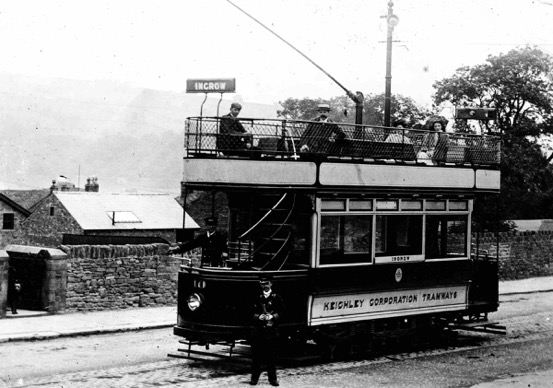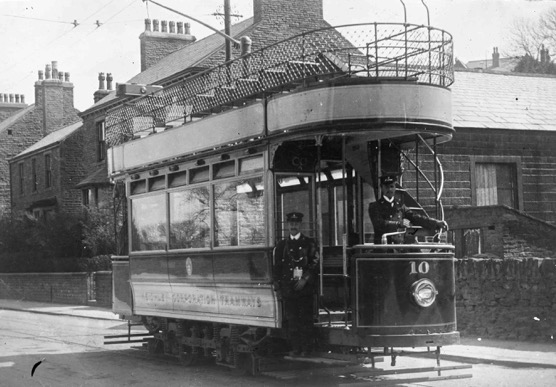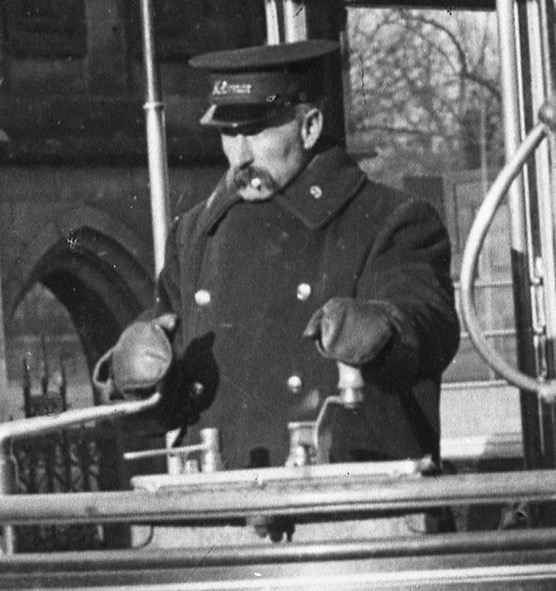Keighley Corporation Tramways
History
Keighley Corporation became a tramway owner on the 25th November 1896, when it took over the tracks of the 4ft-gauge horse-drawn tramway of the Keighley Tramways Company. The company was in dire financial straights, so approached the corporation in 1896 offering to sell the undertaking. This can hardly have been an enticing prospect for the corporation, as the tramway had never made a profit. The undertaking was however a local affair, with many of the KTCo's owners also being councillors, so agreement was reached for the corporation to buy the track and lease it back to the company, the deal being backdated to the 1st July 1896. The cost was a nominal £5, which represented a staggering loss for the company, the line having cost almost £10,000 to lay barely seven years earlier (in 1889).
Soon afterwards however, the corporation's thoughts turned to the new wonder of electricity, and in 1898 it obtained parliamentary powers to convert and extend the horse tramway. Despite a degree of civic opposition, a not entirely unreasonable stance given the tramway's losses, the corporation agreed a price for the KTCo's remaining assets, taking possession of the tramway on the 15th January 1901; the company however continued to work the tramway, the corporation paying them an agreed price per horse per week to do so. The corporation finally took over operation on the 21st September 1901, following which the company was wound up.
The corporation made some attempt to bring its acquisition into reasonably good order, but thereafter seemed happy to take its time in converting it to electric traction. This changed suddenly and unexpectedly in 1902 with the appearance of the ill-fated Mid-Yorkshire Tramways Company, a concern which had grand plans for an extensive tramway network linking — amongst other places — Ilkley, Otley, Shipley, Bingley and Keighley. Although the proposed line between Nab Wood (at the Bingley-Shipley municipal boundary) and Keighley was to enter corporation territory at Stockbridge, the company was more than happy for Keighley to build the portion within its municipal boundary, as long as the company had running rights over it. This forced the corporation into action, powers for an additional line between Keighley and Stockbridge being acquired on the 11th August 1903, with the MYTCo's powers following three days later; that was however to be as far as the company got with its Nab Wood to Stockbridge line, the company failing with significant debts early the following year.
Construction work commenced on the corporation's electric system in February 1904, the last horse car service running on the 28th May, and the first electric service commencing five months later on the 12th October 1904. The Stockbridge line initially only ran as far as Victoria Park Gates, some way short of Stockbridge, the full line not opening until the 10th February 1905. This brought the system to its final extent of 3.44 miles, comprising three lines which met at the Keighley Mechanics Institute at the junction of North Street and Cavendish St. From here the lines ran: southwards to Ingrow Bridge, northwards to Utley and northeastwards to Stockbridge.
The tramway settled down to a fairly untroubled existence, carrying plenty of passengers, with sufficient profits being made to slowly pay off the debt. The corporation toyed with the idea of extending the tramway, but baulked at the likely cost, instead securing powers to operate motor omnibuses, both inside and outside the borough. Following a successful trial, the corporation purchased its own petrol motorbuses, services starting on the 9th April 1909. Although all seem to go fairly well for a while, these were very early days for the petrol motorbus, not only was the technology immature, but it also had to bear the brunt of the appalling state of the roads, which took a heavy toll on the vehicles. The bus services became ever more unreliable, forcing the corporation to take a look at an alternative option, trolley buses, which in the terminology of the day were known trackless trolleys.
Having had its fingers burned once with developing technology, the corporation did not hesitate to plunge its hands back into the fire by opting for the idiosyncratic Cedes-Stoll system. This had a rather bizarre arrangement whereby a trolley ran along two overhead power lines, the electrical feed passing down a flexible cable to the vehicle itself, which had the motors built into the rear wheels. Unfortunately, the motors often ran hot inside their confined casings, which were continually jolted by the poorly made roads, whilst the trolleys sometimes broke loose, leaving the bus stranded whilst they disappeared downhill. Powers to operate the trackless trolleys were obtained in 1912, the first services starting on the 3rd May 1913 from the tramway terminus at Ingrow Bridge to Crossroads, followed by routes to Oakworth and Eastburn, the latter connecting to the Utley tramway terminus. The decision to go with these vehicles was an unmitigated disaster, as was the case at the only other system in the country to use them — Aberdare Corporation Tramways — and is all the more perverse as more proven systems were available. Their sole success was to see off the equally unreliable motorbuses, the last of which was withdrawn in February 1915.
Like most systems up and down the country, the KCT suffered from a loss of staff (and their skills) during the Great War, as well shortages of spares and new materials. On top of these challenges came the woeful Cedes-Stoll trackless trolleys, which were of Austrian manufacture, the British arm of the company being summarily closed down by the government. The KCT now had few spares, apart from what they managed to purchase at the closing sale, no prospect of getting any more, and no access to expertise. By the end of the war, 9 out of a total of 10 vehicles were out of action, and if that wasn't bad enough, the corporation had wasted yet more money by installing overhead wires out to Oxenhope, which it was then prevented from using (during the war) by objections from the County Council.
Following the war, the department poured good money after bad in a futile attempt to make the trackless trolleys reliable; this included converting one to front-wheel drive at a cost that probably could have bought a completely new vehicle, and one that worked at that. By 1921, the Cedes-Stoll trolleys' days were clearly numbered, the loss-making Oxenhope service being withdrawn on the 24th October, and the Oakworth route succumbing on the 3rd December, though here they were replaced by newly-purchased corporation motorbuses.
Meanwhile, the tramway soldiered on, moving large numbers of people for low fares, something that it had done for its entire existence. Although money was spent on overhauling several tramcars, they continued to run over track that was becoming ever more troublesome, having only ever had the barest minimum in terms of renewal. In May 1923, it became apparent that the tramway could not go on for much longer, over 2.5 miles of track being in dire need of replacement, and at considerable expense. This, and the perpetual losses on the trackless trolleys, finally brought some unanimity to the council, a decision being taken in the summer of 1923 to replace both the trams and the remaining Cedes-Stoll trackless trolleys with new 'twin boom' trolleybuses.
Powers to convert the tramway system were acquired in July 1924, the council having already begun to relay various roads, having finally understood that expensive new vehicles and poorly surfaced roads was not a good mix. The Utley tram line closed on the 20th August 1924, followed by the Stockbridge line on the 20th November and the Ingrow line on the 13th December. Although this was the official closure date, the trams continued to run peak-demand workmen's services for a few more days, until the 17th December 1924, when the last tram ran. The bright new 'twin boom' trolleys were to follow them into oblivion barely 8 years later.
The closure gave Keighley Corporation the rather dubious honour of being the first municipal authority in the British Isles to abandon its electric tramway. The debt remaining on the tramway was almost identical to that which had accumulated on the Cedes-Stoll trackless trolleys, which although much cheaper, had been operated for most of their existence at a significant loss. It is tempting to speculate on what could have been had the corporation spent this money on the tramway.
Uniforms
Photographs taken during the period when the corporation worked the horse car services (September 1901 to May 1904) are rare, but those that have survived strongly suggest that it continued the company practice of allowing tramcar staff to wear informal attire.
Good quality photographs depicting staff from the electric era are also surprisingly rare, possibly reflecting its short existence (just over 20 years). Surviving photographs suggest that uniforms may not have been available in time for the opening, as everyone in them is wearing informal attire; it is however entirely possible that those depicted are corporation officials rather than de facto motormen and conductors. When issued, uniforms took the form of double-breasted jackets with five pairs of buttons (bearing the full system title — see link) and lapels; the latter certainly bore insignia of some kind, probably employee numbers, though these cannot be made out with certainty on the surviving photographs. Caps were military in style with a tensioned crown (top) and carried script-lettering grade badges — either Motorman or Conductor — above which a small badge was worn, more than likely an employee number or a municipal device of some description. It is likely that the style of uniform was changed around the time of the Great War, though photographic evidence remains stubbornly elusive.
Tramcar crews were also issued with long double-breasted greatcoats with high, fold-over collars; the latter bore an employee number on the bearer's left-hand side, though what was carried on the opposite collar remains for now unclear.
Inspectors — at least prior to the Great War — wore single-breasted jackets with hidden buttons (or more likely a hook and eye affair), edged in a finer material than the main body of the jacket, and with upright collars; the latter probably carried Inspector in embroidered script lettering. Caps were in a kepi style and almost certainly bore the grade — Inspector — on a hat band in embroidered script lettering.
In common with many tramway operators, Keighley employed the services of women during the Great War to replace male staff lost to the armed services. The first six conductresses were taken on in April 1916 and were followed by a number of motorwomen in December of the same year. Just a single photograph of these ladies appears to have survived, though it does include several conductresses. Conductresses were issued with tailored, single-breasted jackets with breast pockets (with button closures) and high fold-over collars; the latter do not appear to have borne any insignia. A long matching skirt was also provided. Headwear took the form of a dark-coloured, water-proof bonnet, though this may in fact have been specifically for winter use. The bonnets bore a ribbon-like hat band; it is unclear whether this bore any insignia.
The aforementioned photograph also shows a lady who is more than likely an inspectress. She has a single-breasted jacket that is almost identical to those worn by conductresses, but with button-fastened epaulettes. Headgear comprised a baggy peaked cap that bore a large cap badge; the latter may however have been a military badge (this was a relatively common practice in the Great War), as her male counterparts certainly did not have large badges on their caps.
Further reading
For a full history of the system, see: Keighley Corporation Transport by J S King; The Advertiser Press Limited (1964).
Images
Horse tram drivers and conductors
An unidentified Keighley horse tram — photo undated, but in view of the lack of a company name, almost certainly taken after the full corporation take-over of late 1901. The driver is wearing informal attire, including a knee blanket. Author's Collection.
Motormen and conductors
An absolutely pristine Tramcar No 10 standing at the terminus at Utley — photo undated, but almost certainly taken in the summer of 1905. Photograph courtesy of the National Tramway Museum. 
A blow-up of the above photo showing the motorman and conductor, both of whom are wearing double-breasted jackets with lapels, along with military-style caps bearing standard, 'off-the-shelf' script-lettering grade badges.
The crew of Tramcar No 10 pose once again for the camera, also at Utley, but seen from the opposite direction to the preceding photo — photo undated, but almost certainly taken in the summer of 1905. Photograph courtesy of the National Tramway Museum. 
A blow-up of the above photo showing the conductor and motorman; both men are wearing script-lettering grade badges, with a small badge above, most likely a municipal device or an employee number.
General pattern script-lettering brass cap badges — Motorman and Conductor — of the type used by Keighley Corporation Tramways.
A tramcar — either No 9 or No 10 — pictured at Holker St, heavily decorated to mark the occasion of a French visit on 3rd September 1905. The motorman is wearing the usual double-breasted jacket with lapels. Author's Collection.
A motorman at the controls of Tramcar No 12 outside the entrance to Cliffe Castle in 1906. Photograph courtesy of the National Tramway Museum. 
A blow-up of the above photo showing the motorman. His collar insignia reveal that he is Employee No 9, whilst his cap carries a standard, script-lettering Motorman grade badge.
Tramcar No 8 outside the Mechanics Institute in 1922. Photo courtesy of the Tramways and Light Railway Society, with thanks to David Voice.
A blow-up of the above photo showing the motorman, though precious little of his uniform can be discerned.